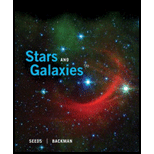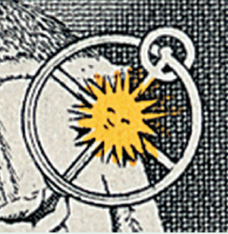
Stars and Galaxies
9th Edition
ISBN: 9781305120785
Author: Michael A. Seeds, Dana Backman
Publisher: Cengage Learning
expand_more
expand_more
format_list_bulleted
Textbook Question
Chapter 4, Problem 3LL

What three astronomical objects are represented here? What are the two rings?
Expert Solution & Answer
Want to see the full answer?
Check out a sample textbook solution
Students have asked these similar questions
Imagine a telescope was placed on the
planet Mercury and was used to measure
the positions of stars in the sky.
Assuming Mercury follows a circular orbit
with a semi-major axis = 0.387 AU and a
period = 88 days, calculate the maximum
%3D
stellar aberration that would be detected,
expressing your answer in arcseconds.
Choose the option below that best
matches your answer.
Select one:
Оа.
100
O b. 25
О с
60
O d. 15
O e.
33
From a distance of 800 km above the surface of the
Moon, what is the angular diameter of an astronaut
in a spacesuit who has a linear diameter of 0.8 m
viewed from above? (won Use the small-angle formula,
angular diameter (in arc seconds) linear diameter
2.06 x 105
distance
arc seconds
The unaided human eye has a resolution of about
100 arc seconds in bright lighting conditions. Could
someone looking out the command module
window have seen the astronauts on the Moon?
Yes
No
What is an Astronomical Unit (AU) based on?
Chapter 4 Solutions
Stars and Galaxies
Ch. 4 - Prob. 1RQCh. 4 - Prob. 2RQCh. 4 - Prob. 3RQCh. 4 - Prob. 4RQCh. 4 - Prob. 5RQCh. 4 - Prob. 6RQCh. 4 - Which two-dimensional (2D) and three-dimensional...Ch. 4 - Prob. 8RQCh. 4 - Prob. 9RQCh. 4 - Prob. 11RQ
Ch. 4 - Prob. 12RQCh. 4 - Prob. 13RQCh. 4 - Prob. 14RQCh. 4 - Prob. 16RQCh. 4 - Prob. 17RQCh. 4 - Prob. 18RQCh. 4 - Prob. 19RQCh. 4 - Prob. 20RQCh. 4 - Prob. 21RQCh. 4 - Prob. 22RQCh. 4 - How did the Alfonsine Tables, the Prutenic Tables,...Ch. 4 - Prob. 24RQCh. 4 - Prob. 25RQCh. 4 - Prob. 26RQCh. 4 - Prob. 27RQCh. 4 - Draw and label a diagram of the western horizon...Ch. 4 - Prob. 2PCh. 4 - Prob. 3PCh. 4 - Prob. 4PCh. 4 - Prob. 5PCh. 4 - Prob. 6PCh. 4 - One planet is three times farther from the Sun...Ch. 4 - Prob. 9PCh. 4 - Prob. 10PCh. 4 - Prob. 11PCh. 4 - Prob. 1LLCh. 4 - Prob. 2LLCh. 4 - What three astronomical objects are represented...Ch. 4 - Prob. 4LL
Knowledge Booster
Learn more about
Need a deep-dive on the concept behind this application? Look no further. Learn more about this topic, physics and related others by exploring similar questions and additional content below.Similar questions
- 1arrow_forwardNext you will (1) convert your measurement of the semi-major axis from arcseconds to AU, (2) convert your measurement of the period from days to years, and (3) calculate the mass of the planet using Newton's form of Kepler's Third Law. Use Stellarium to find the distance to the planet when Skynet took any of your images, in AU. Answer: 4.322 AU Use this equation to determine a conversion factor from 1 arcsecond to AU at the planet's distance. You will need to convert ? = 1 arcsecond to degrees first. Answer: 2.096e-5 AU (2 x 3.14 x 4.322 x (.000278/360) = 2.096e-5) Next, use this number to convert your measurement of the moon's orbital semi-major axis from arcseconds to AU. A) Calculate a in AU. B) Convert your measurement of the moon's orbital period from days to years. C) By Newton's form of Kepler's third law, calculate the mass of the planet. D) Finally, convert the planet's mass to Earth masses: 1 solar mass = 333,000 Earth masses.arrow_forwardWhat are the three basic components of a modern astronomical instrument? Describe each in one to two sentences. (Select all that apply.) a magnifier, which increases the size of the image a motor, which allows the telescope to track sorces as they move a detector, which senses and records the radiation an eyepiece, where an astronomer can view the image created a telescope, which collects radiation a device which sorts radiation by wavelength Karrow_forward
- calculate the angular size of a Jupiter-sized planet that is located in a star system 5 light years away from us (express your answer in arcseconds)arrow_forwardThe distance light travels in one second(one light-second) is about 1.86×10⁵ mi. Saturn is about 475 light-seconds from the sun. About how many miles from the sun is Saturn?arrow_forwardA planet was recently discovered orbiting the star Proxima Centauri, with an orbital radius of 0.05 AU. As seen from Earth, what is the maximum angular separation between this planet and Proxima Centauri, in arcseconds? The distance to Proxima Centauri is 4.24 light-years.arrow_forward
arrow_back_ios
SEE MORE QUESTIONS
arrow_forward_ios
Recommended textbooks for you
 Stars and Galaxies (MindTap Course List)PhysicsISBN:9781337399944Author:Michael A. SeedsPublisher:Cengage Learning
Stars and Galaxies (MindTap Course List)PhysicsISBN:9781337399944Author:Michael A. SeedsPublisher:Cengage Learning Horizons: Exploring the Universe (MindTap Course ...PhysicsISBN:9781305960961Author:Michael A. Seeds, Dana BackmanPublisher:Cengage Learning
Horizons: Exploring the Universe (MindTap Course ...PhysicsISBN:9781305960961Author:Michael A. Seeds, Dana BackmanPublisher:Cengage Learning AstronomyPhysicsISBN:9781938168284Author:Andrew Fraknoi; David Morrison; Sidney C. WolffPublisher:OpenStax
AstronomyPhysicsISBN:9781938168284Author:Andrew Fraknoi; David Morrison; Sidney C. WolffPublisher:OpenStax Foundations of Astronomy (MindTap Course List)PhysicsISBN:9781337399920Author:Michael A. Seeds, Dana BackmanPublisher:Cengage Learning
Foundations of Astronomy (MindTap Course List)PhysicsISBN:9781337399920Author:Michael A. Seeds, Dana BackmanPublisher:Cengage Learning


Stars and Galaxies (MindTap Course List)
Physics
ISBN:9781337399944
Author:Michael A. Seeds
Publisher:Cengage Learning

Horizons: Exploring the Universe (MindTap Course ...
Physics
ISBN:9781305960961
Author:Michael A. Seeds, Dana Backman
Publisher:Cengage Learning

Astronomy
Physics
ISBN:9781938168284
Author:Andrew Fraknoi; David Morrison; Sidney C. Wolff
Publisher:OpenStax

Foundations of Astronomy (MindTap Course List)
Physics
ISBN:9781337399920
Author:Michael A. Seeds, Dana Backman
Publisher:Cengage Learning


Time Dilation - Einstein's Theory Of Relativity Explained!; Author: Science ABC;https://www.youtube.com/watch?v=yuD34tEpRFw;License: Standard YouTube License, CC-BY